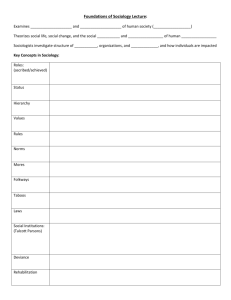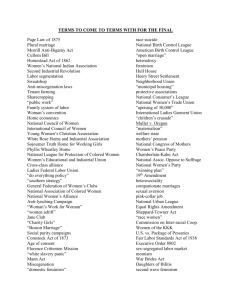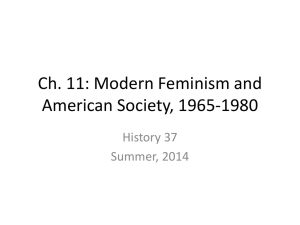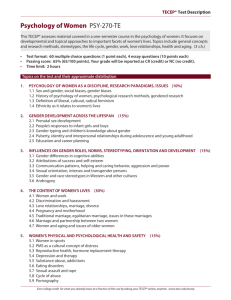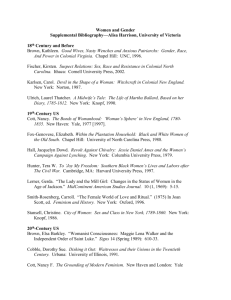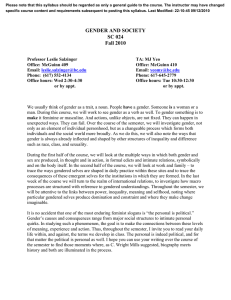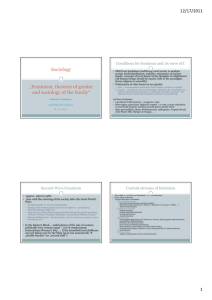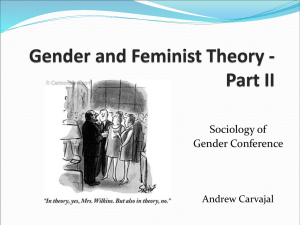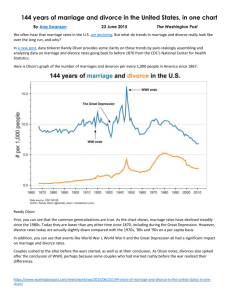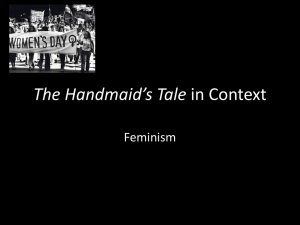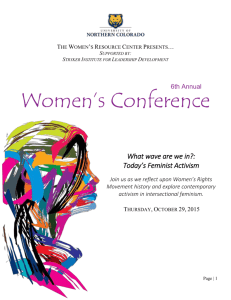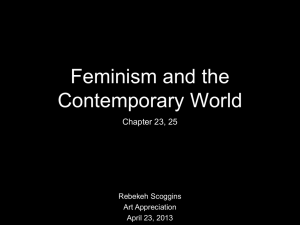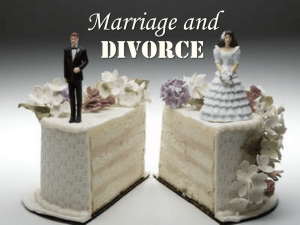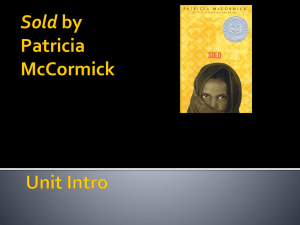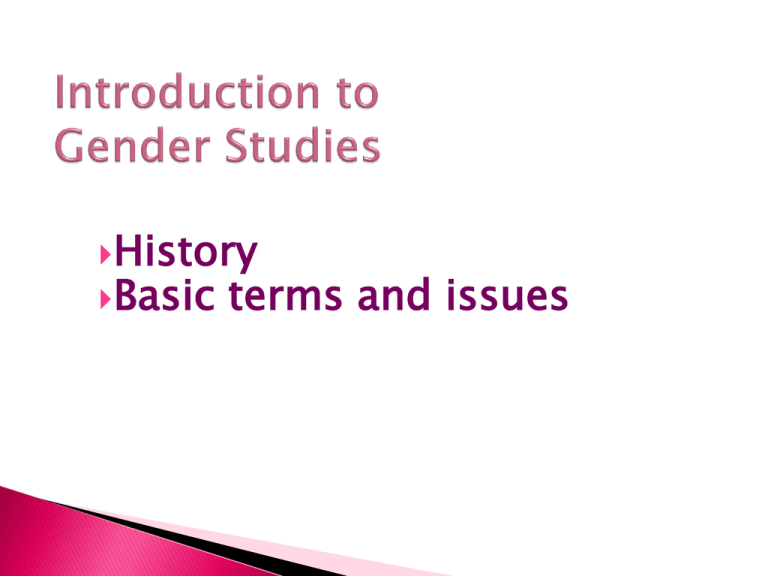
History
Basic
terms and issues
concept of the autonomous, sovereign
individual
women: excluded
Bluestockings
Rebecca West (1892-1983): "People call
me a feminist whenever I express
sentiments that differentiate me from a
doormat "
“By marriage, the husband and wife are
one person in law: that is, the very being
or legal existence of the woman is
suspended during marriage, or at least
incorporated and consolidated into that
of the husband: under whose wing,
protection and cover, she performs every
thing; and is therefore called in our lawfrench fem-couvert.”
“A woman’s preaching is like a dog
walking on its hind legs. It is not done
well; but you are surprised to find it at
all.”
if a woman happened to have “any
learning, [she should] keep it a profound
secret, especially from the men.”
novels helped “render women more artificial and weak
characters than they would otherwise have been.”
novels inspire in girls “false notions and hopes, teach them
affectation, and shake their principles by presenting love as
irresistible, love at first sight.”
“Soft phrases, susceptibility of heart, delicacy of sentiment,
and refinement of taste, are almost synonymous with epithets
of weakness ... those beings who are only the objects of pity ...
will soon become objects of contempt.”
“the cultivation of understanding is always subordinate to the
acquirement of some corporeal accomplishment”; “sensibility
is nurtured at the expense of understanding”
“Man does, woman is”
“Man for the field and woman for the
hearth;
Man for the sword and for the needle
she;
Man with the head and woman with the
heart
Man to command and woman to obey
All else confusion.”
Middle-class, charity, extension of home duties to
the public
Mary Wollstonecraft: A Vindication of the Rights of
Woman (1792)
Jeremy Bentham: Plan of Parliamentary Reform in
the Form of Catechism (1817)
William Thompson/Anns Wheeler: An Appeal of
One Half of the Human Race, Women, Against the
Pretensions of the Other Half, Men (1825)
Nightingale: The woman with the lamp; Crimean war
Florence
Barbara Bodichon: Objections to the Enfranchisement of
Women Considered (1866)
Josephine E. Butler: The Education and Employment of
Women (1868)
Francis Power Cobbe: Criminals, Idiots, Women and
Minors (1869)
John Stuart Mill: The Subjection of Women (1869)
Barbara Bodichon: Reasons for and against the
Enfranchisement of Women (1872)
mid-19th-c.: London College, Queen’s College
less prestigious universities admitted women and
granted degrees
most resistant: Oxford and Cambridge
women’s colleges (Oxford: Somerville, St.
Catherine’s; Cambridge: Newnham and Girton),
But: no degrees
excluded from the most prestigious (medical and
legal) professions.
1891: right to inherit from their husbands (cf.: Austen)
1893: allowed to manage their own property completely
free of the husband
1907: complete control of their wages
Divorce: 1857: Matrimonial Cause Bill: on different grounds,
but even a woman could initiate a divorce
1884: awarded financial maintenance to the successful
petitioner
1923: set the same grounds of divorce for both sexes
1918 : suffrage (right to vote); but: women householders or
wives of male householders over 30 (men: 21)
1928: on the same grounds as men
“Nature’s darling woman is a stay-athome woman, a woman who wants to
be a good wife and a good mother, and
cares very little for anything else.” (Henry
A. Jones, The Case of Rebellious Susan,
1894)
by 1900 women had become “free both
in their persons and their properties, their
money and their consciences, their
bodies and their souls.”
the suffragists: Henry and Millicent
Fawcett’s National Union of Women’s
Suffrage Societies (NUWSS; 1897)
the suffragettes, Emmeline Pankhurst’s
Women’s Social and Political Union
(WSPU;1903)
1870–1914: number of women clerks
multiplied 20 times — male fear of job
competition
1914: basic legal rights to join education
fully, and to enter the professions—formal
legal barriers removed — but not
practice yet (cultural conditioning: semiprofessions: nurses, librarians — and
temporary work)
50% increase in working women; 700,000
women replaced men directly in the
labour market
“war girls”
1918: Marie Stopes: Married Love, a book offering
contraceptive advice
1921: birth-control clinic
agitation for communal childcare centres
Companionate marriage;
Dora Russell (Bertrand Russell’s wife): “sex, even
without marriage and without children … is a thing
of dignity, beauty and delight.”
sacking of women; marriage bar, unequal pay
(47% of men’s pay)
1920: Oxford grants degrees to women
1923: women teachers banned from employment if
married; general tendency: withdrawal of women
from the labour market
“feminism’s awkward age,” a push towards
domesticity in the 20s and 30s
“tranquillised 50s”
European/Continental
Related to the socialist movements
(internationals)
Primary issue: class equality – women’s rights:
„side effect” (corollary effect)
International women’s day
◦ Not about flowers
◦ Clara Zetkin: 2nd International Women’s Congress,
Copenhagen
◦ 8 March: from 1913 on
◦ in memory of female textile workers’ demonstration
in New York for equal pay in 1857
3/3/14
essentialism -- social constructionism
Simone de Beauvoir: “One is not born, but
becomes a woman.”
One/the Other
Subject/the Inessential
The Absolute/ the relative being
Betty Friedan: The Feminine Mystique
The problem that has no name
The most comfortable concentration camp
Against latent discrimination
Cultural-political
Theoretical
Institutionalisation
Gender mainstreaming
Rethinking of the private and the public
Gender: concept valid in all walks of life
Right to one’s bodies (against violence against
women)
Feminisms: theoretically, thematically, politically
Target groups: multiplication, intersections
3/3/14
3/3/14
State socialist countries: forced emancipation –
the burden of the past in the ex-Eastern block
Woman’s double workload (full-time work +
housework)
Lack of restructuring the private
Discrimination in the public (often: token women)
Claim: feminism: no longer needed (problems
solved; „western” feminism: ridiculed, frowned
upon); whereas: women: „used”
After the political changes: conservative
turn//emergence of second-wave feminism in
the post-socialist countries too
Problem: confluence of various tendencies,
including backlash (argument: feminism is
outdated)
3/3/14
Thank you for your attention!

